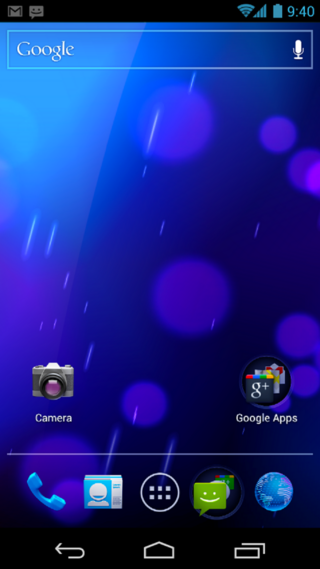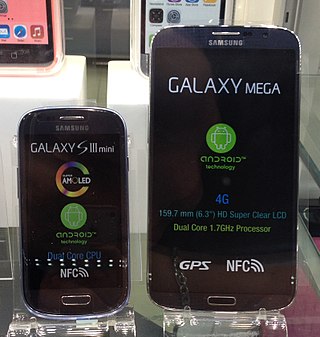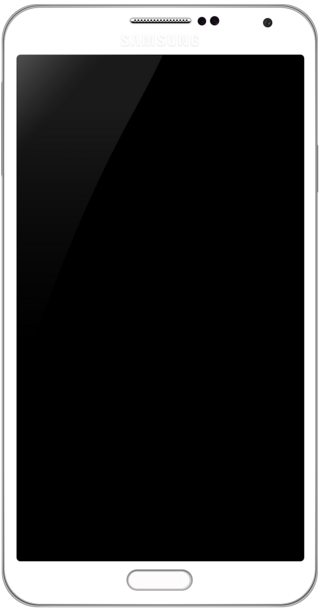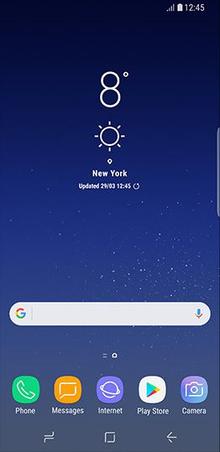
Google Calendar is a time-management and scheduling calendar service developed by Google. It became available in beta release April 13, 2006, and in general release in July 2009, on the web and as mobile apps for the Android and iOS platforms.
The Samsung Behold II is a touch-screen, 3G- compatible smartphone with a 5.0-megapixel camera. The Samsung Behold II is powered by the Android OS, making it the fourth Android powered phone by T-Mobile USA. Other Android powered phones by T-Mobile are the G1, myTouch 3G, and the Motorola CLIQ. It was released on November 18, 2009. On May 27, 2010, Samsung announced that Android 1.6 "Donut" would be the final firmware release for the device.
A smart TV, also known as a connected TV (CTV), is a traditional television set with integrated Internet and interactive Web 2.0 features, which allows users to stream music and videos, browse the internet, and view photos. Smart TVs are a technological convergence of computers, televisions, and digital media players. Besides the traditional functions of television sets provided through traditional broadcasting media, these devices can provide access to over-the-top media services such as streaming television and internet radio, along with home networking access.

A smartwatch is a wearable computer in the form of a watch; modern smartwatches provide a local touchscreen interface for daily use, while an associated smartphone app provides management and telemetry, such as long-term biomonitoring. While early models could perform basic tasks, such as calculations, digital time telling, translations, and game-playing, smartwatches released since 2015 have more general functionality closer to smartphones, including mobile apps, a mobile operating system and WiFi/Bluetooth connectivity. Some smartwatches function as portable media players, with FM radio and playback of digital audio and video files via a Bluetooth headset. Some models, called watch phones, have mobile cellular functionality such as making telephone calls.

A smart refrigerator, also known as internet refrigerator, is a refrigerator which is able to communicate with the internet. This kind of refrigerator is often equipped to determine itself whenever a food item needs to be replenished. This still partly done by the human factor the next evolution of smart is the Intelligent Refrigerator adding infantry tracking on all the items inside the fridge and payment flow to the mix like connecting it to an online retail store to always have a full fridge at home for domestic use and for Commercial use payment terminal and lock are added for thinks like unmade retail and queue busting.

Android Ice Cream Sandwich is the fourth major version of the Android mobile operating system developed by Google. Unveiled on October 19, 2011, Android 4.0 builds upon the significant changes made by the tablet-only release Android Honeycomb, in an effort to create a unified platform for both smartphones and tablets. The first phone with Android Ice Cream Sandwich was Samsung Galaxy Nexus.

ChatON was a global mobile communication service introduced by Samsung Electronics in September 2011. ChatON served more than 120 countries in 62 languages. ChatON was available on Android, iOS, BlackBerry, Windows Phone, Windows Mobile (Korea), and Bada smartphones. Additionally, a web client was offered for access to the service via web browsers. Users could invite and register buddies via Facebook and Twitter as well as share ChatON content on Facebook. Among ChatON's unique features were allowing users to create Animation messages, Broadcast to send personal notices in a group chat room, and the Trunk which stores media files shared in chats. When a user logs in ChatON, the user's buddy list is available on any connected device.
The Samsung Galaxy Express (GT-I8730) is a smartphone made by Samsung which was launched in March 2013 in India featuring a similar design to the Galaxy S Duos but with additional features such as 4G LTE, NFC. It also features a bigger 4.5-inch screen with Super AMOLED Plus and retains all the features which the Samsung Galaxy S III phone has.

The Samsung Galaxy Mega is an Android-based phablet that was manufactured and released by Samsung. It was announced on April 11, 2013. The original model featured a 6.3 in (160 mm) screen, though a revised version was released with a 5.8 in (150 mm) screen. It has a 1,280×720 screen, a dual-core 1.7 GHz processor and an 8-megapixel camera. The phone runs Android 4.2.2 "Jelly Bean" software, and internal storage is 8 or 16 GB.

The Samsung Galaxy Note 3 is an Android phablet smartphone produced by Samsung Electronics as part of the Samsung Galaxy Note series. The Galaxy Note 3 was unveiled on September 4, 2013, with its worldwide release beginning later in the month. Serving as a successor to the Galaxy Note II, the Note 3 was designed to have a lighter, more upscale design than previous iterations of the Galaxy Note series, and to expand upon the stylus and multitasking-oriented functionality in its software—which includes a new pie menu opened through the button on the stylus for quick access to pen-enabled apps, along with pop-up apps and expanded multi-window functionality. It additionally features new sensors, a USB 3.0 port, 3 GB of RAM, and its video camera has been upgraded to 2160p (4K) resolution and doubled framerate of 60 at 1080p, placing it among the earliest smartphones to be equipped with any of these.
The Samsung Galaxy Express 2 (SM-G3815) is a smartphone made by Samsung which was launched in October 2013 featuring a similar design and specifications of the Samsung Galaxy S4 Mini but with a bigger 4.5 inch screen and different cameras.

The Samsung Gear 2 and Samsung Gear 2 Neo are smartwatches produced by Samsung Electronics. Unveiled on February 22, 2014 at Mobile World Congress, the Gear 2 line is a successor to the Samsung Galaxy Gear.
Acompli is a discontinued mobile app that allowed for user interaction with email messages as well as management of multiple email accounts in one programme. In addition, the tool also organized one's calendar and shared files. This application provided for integration with cloud storage platforms such as Dropbox, OneDrive, and iCloud; it also carried support for Microsoft Exchange and Gmail. Acompli launched on 24 April 2014. The startup company, which had $7.3 million in funding, was led by CEO Javier Soltero, J.J. Zhuang (CTO) and Kevin Henrikson.

Google Nest, previously named Google Home, is a line of smart speakers developed by Google under the Google Nest brand. The devices enable users to speak voice commands to interact with services through Google Assistant, the company's virtual assistant. Both in-house and third-party services are integrated, allowing users to listen to music, control playback of videos or photos, or receive news updates entirely by voice. Google Nest devices also have integrated support for home automation, letting users control smart home appliances with their voice command. The first device, Google Home, was released in the United States in November 2016; subsequent product releases have occurred globally since 2017.

Google Assistant is a virtual assistant software application developed by Google that is primarily available on mobile and home automation devices. Based on artificial intelligence, Google Assistant can engage in two-way conversations, unlike the company's previous virtual assistant, Google Now.

Samsung Experience was a software overlay for the Android "launcher" by Samsung for its Galaxy devices running Android 7.x “Nougat” and Android 8.x “Oreo”. It was introduced in late 2016 on a beta build based on Android 7.0 “Nougat” for the Galaxy S7, succeeding TouchWiz. It has been succeeded in 2018 by One UI based on Android 9 “Pie” and later versions.

Bixby is a virtual assistant developed by Samsung Electronics. It runs on various Samsung branded appliances, primarily mobile devices but also on some refrigerators. Bixby was launched in 2017, replacing the previous S Voice assistant.

Google Pay is a mobile payment service developed by Google to power in-app, online, and in-person contactless purchases on mobile devices, enabling users to make payments with Android phones, tablets, or watches. Users can authenticate via a PIN, passcode, or biometrics such as 3D face scanning or fingerprint recognition.
LG ThinQ is a brand launched by LG Electronics in 2017, featuring products that are equipped with voice control and artificial intelligence technology. The brand was originally launched for home appliances and consumer electronics, such as refrigerators and air conditioners. In February 2018, LG announced the LG V30S ThinQ, which is the first phone to have the "ThinQ" branding.
The HomeSync is an Android TV box and home server combo developed by Samsung Mobile. The unit is a full Android Jelly Bean device with a hard drive. While all other connected television units made by Samsung ran Orsay-based Samsung Smart TVs, due to the fact the HomeSync is made by Samsung's mobile division, it ran a skin of Android Jelly Bean. The HomeSync at launch was compatible with the Samsung Galaxy S4 Samsung Galaxy Note 3, Samsung Galaxy S III, Samsung Galaxy Note II, Samsung Galaxy Note 8.0, Samsung Galaxy Note 10.1 2014 Edition and Samsung Galaxy Camera. Others may have been supported if they had a protocol called "Samsung Link". The specs are noted to resemble the Ouya video game console minus the hard drive. It was announced in February 2013 at Mobile World Congress. It has been compared to the Apple TV series by Apple, which also integrated with iOS devices, but did not have network storage and cost less. The console features a 50 USD credit for Media Hub when you buy a HomeSync. On December 17, Samsung made most Android devices support the unit by adding it to the Play Store, also widening support of Samsung phones. Shortly before it launched, the store page and manual were available but unable to be bought.












